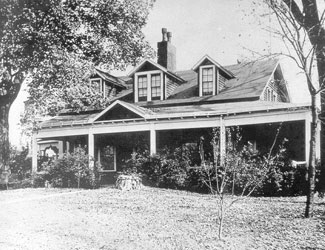Slide 9

The Chase farm in Worthington, Ohio
What would become Kenyon College began on Chaseís farm in Worthington with only a handful of students. Erastus Burr, one of Kenyonís first students, would later write about his time at Kenyon in Worthington.
Sometime in May of this year (1825), Mr. Sparrow came and took our studies in charge-- the same who had taught some years previously in the Worthington Academy. Mr. Sparrow proved to be a very exacting teacher, and yet it was easier to prepare, and I had felt happier in preparing, for his recitations than for those of any other teacher. Mr. S. was not long the sole teacher. Soon after, a Mr. McMillan was engaged as tutor, or grammar school instructor, and left Professor Sparrow with Latin, Greek, and Mathematics. Students were now coming in considerable numbers. By the end of this year (1825), there were twenty-five. To accomodate so many, the Bishop erected several log buildings in the spacious grounds about his residence. The farm consisted of 160 acres. It lay on both sides of the State road from Columbus to Sandusky and Cleveland. From Columbus it was eight miles.
The buildings erected were four in number, one for a dining hall, about sixty by twenty-five feet, adjacent to the kitchen; another, somewhat larger, for a school-room, chapel, etc. The other two were of smaller size, and were for studentís rooms. All these buildings were of unhewn logs covered with "clap-boards", and these were held in place by logs laid across course. A farm house some distance off across a field was also brought into requisition. It had been erected by Bishop Chase in 1817, and occupied by his family while his permanent dwelling was being built. At the first, when the students were few in number, say from ten to fifteen, we took our meals at the Bishopís table, Mrs. Chase presiding. The Bishop was much away, but when at home our mealtime was greatly enlivened by his amusing stories and narration of events which his varied experience furnished. Afterwards, the long dining hall, with two tables extending nearly its whole length, was requisite for the increased number of hungry boys.

